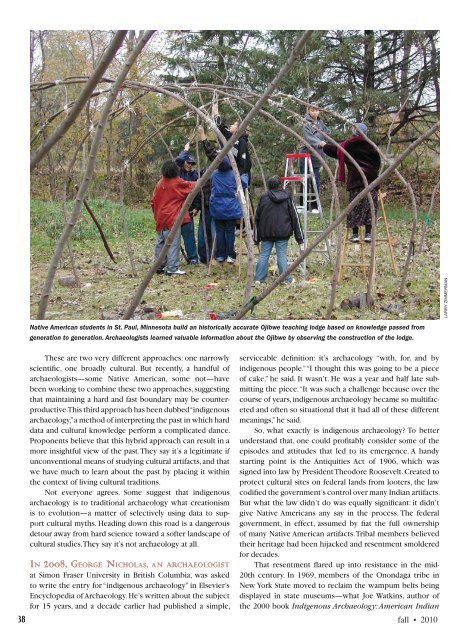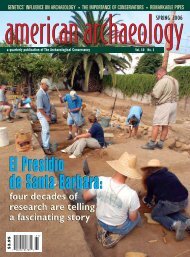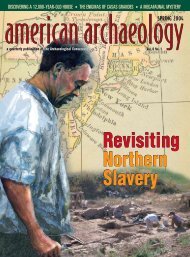Clovis Comet Debate - The Archaeological Conservancy
Clovis Comet Debate - The Archaeological Conservancy
Clovis Comet Debate - The Archaeological Conservancy
Create successful ePaper yourself
Turn your PDF publications into a flip-book with our unique Google optimized e-Paper software.
Native American students in St. Paul, Minnesota build an historically accurate Ojibwe teaching lodge based on knowledge passed from<br />
generation to generation. Archaeologists learned valuable information about the Ojibwe by observing the construction of the lodge.<br />
<strong>The</strong>se are two very different approaches: one narrowly<br />
scientific, one broadly cultural. But recently, a handful of<br />
archaeologists—some Native American, some not—have<br />
been working to combine these two approaches, suggesting<br />
that maintaining a hard and fast boundary may be counterproductive.<br />
This third approach has been dubbed “indigenous<br />
archaeology,” a method of interpreting the past in which hard<br />
data and cultural knowledge perform a complicated dance.<br />
Proponents believe that this hybrid approach can result in a<br />
more insightful view of the past. <strong>The</strong>y say it’s a legitimate if<br />
unconventional means of studying cultural artifacts, and that<br />
we have much to learn about the past by placing it within<br />
the context of living cultural traditions.<br />
Not everyone agrees. Some suggest that indigenous<br />
archaeology is to traditional archaeology what creationism<br />
is to evolution—a matter of selectively using data to support<br />
cultural myths. Heading down this road is a dangerous<br />
detour away from hard science toward a softer landscape of<br />
cultural studies. <strong>The</strong>y say it’s not archaeology at all.<br />
In 2008, ge o rg e nI c h o l a s, an a rc h a e o l o g I s t<br />
at Simon Fraser University in British Columbia, was asked<br />
to write the entry for “indigenous archaeology” in Elsevier’s<br />
Encyclopedia of Archaeology. He’s written about the subject<br />
for 15 years, and a decade earlier had published a simple,<br />
serviceable definition: it’s archaeology “with, for, and by<br />
indigenous people.” “I thought this was going to be a piece<br />
of cake,” he said. It wasn’t. He was a year and half late submitting<br />
the piece. “It was such a challenge because over the<br />
course of years, indigenous archaeology became so multifaceted<br />
and often so situational that it had all of these different<br />
meanings,” he said.<br />
So, what exactly is indigenous archaeology? To better<br />
understand that, one could profitably consider some of the<br />
episodes and attitudes that led to its emergence. A handy<br />
starting point is the Antiquities Act of 1906, which was<br />
signed into law by President <strong>The</strong>odore Roosevelt. Created to<br />
protect cultural sites on federal lands from looters, the law<br />
codified the government’s control over many Indian artifacts.<br />
But what the law didn’t do was equally significant: it didn’t<br />
give Native Americans any say in the process. <strong>The</strong> federal<br />
government, in effect, assumed by fiat the full ownership<br />
of many Native American artifacts. Tribal members believed<br />
their heritage had been hijacked and resentment smoldered<br />
for decades.<br />
That resentment flared up into resistance in the mid-<br />
20th century. In 1969, members of the Onondaga tribe in<br />
New York State moved to reclaim the wampum belts being<br />
displayed in state museums—what Joe Watkins, author of<br />
the 2000 book Indigenous Archaeology: American Indian<br />
38 fall • 2010<br />
larry zimmerman




